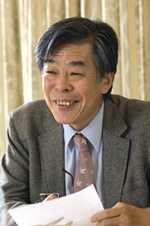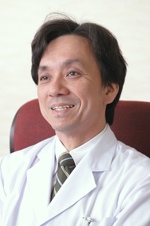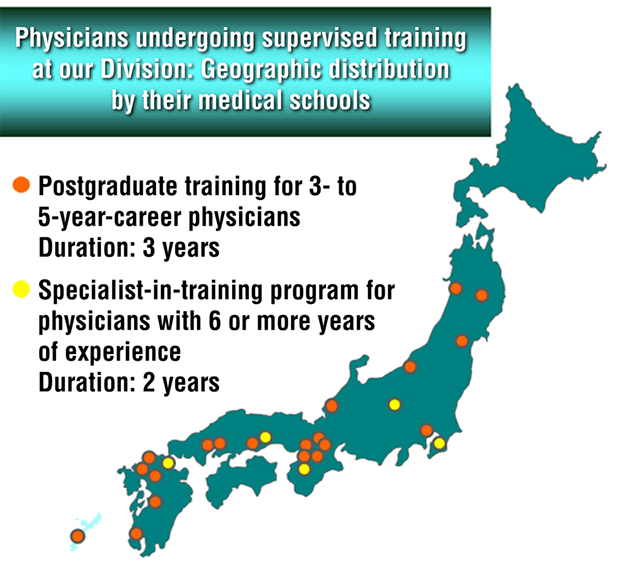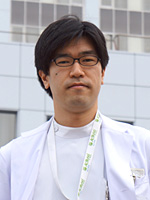Division of Cerebrovascular Medicine and Neurology
To want toTrainee
- For details about training, see "Recruitment of physicians in training for specialist certification (residents or physicians in specialty training)."
- For the Division of Cerebrovascular Medicine and Neurology training curriculum, check "Curriculum of each division > Department of Stroke and Cerebrovascular Diseases."
Junior Physicians Interested in Stroke Medicine

Prof. Vladimir Hachinski, who was also Editor-in-Chief of the Stroke journal, once wrote: "Few areas of medicine are undergoing a greater transformation from nihilism to activism than stroke."Thirty years ago, people believed that a stroke could not be definitively diagnosed until after a person died. The wonder drug alteplase (tissue plasminogen activator [tPA]) was first approved in the USA in 1996. The advent of tPA has revolutionized stroke care in Japan, and national health insurance coverage of stroke care unit (SCU) services is one example of such changes.
In the days of nihilism, NCVC Hospital launched SCU services and specialist training programs, and these efforts heralded activism. I was admitted to the specialist training course in the second year of its inception and moved from Kyushu to Osaka. Dr. Takenori Yamaguchi, who was then the head of the Department (currently NCVC Board Director and Chair of the Japan Stroke Association), assigned me to lead an acute stroke care project. Since then, I have been working at NCVC Hospital. Over the past 30 years, many aspiring young physicians came from different parts of Japan to learn and practice stroke care under my supervision. I partnered with them, partaking in strenuous work duties. I am proud that they have developed broad expertise to lead stroke care in Japan, and one of them has become a medical professor in stroke medicine.
February 2010, Kazuo Minematsu, NCVC Director General Emeritus
A Call for Young Men and Women of the New Age

Stroke is a global disease. Internal medicine represents the basis for the prevention, acute care, and postacute management of stroke, on which surgical and endovascular interventions are designed and implemented. Despite the clinical significance of internal medicine in stroke care, there is an absolute shortage in the number of stroke physicians.
Since its inception, NCVC Hospital has been dedicated to stroke medicine. Our forerunners successfully "grafted"stroke care strategies onto the roots of general medicine during times of chaos. Following their path, we have created and raised our banners. Under the latest national administrative reform last spring, NCVC underwent significant structural reorganization, which gave us many new tasks to achieve. Despite these changes, fostering next-generation physicians and surgeons remains one of our greatest missions. Some doctors practice medicine at NCVC Hospital for a few years, while others stay for shorter periods. I am proud that doctors who received education and training at NCVC Hospital started to call it "school."We have many things to learn from the younger generations, and interactions across different generations will benefit all individuals involved.
The poet William Blake once said:
Rouse up, O Young Men of the New Age! Set your foreheads against the ignorant hirelings!
What are the ignorant hirelings? Diseases, organizational shortcomings, or your weaknesses?
We call out for those health care practitioners who are ready to stand up against those hirelings: "Come to this school."
August 2010, Kazunori Toyoda, NCVC Hospital Vice President
Physicians Who Wish to Receive Education and Training at the Division of Cerebrovascular Medicine and Neurology
Although major advancements have recently been made in acute stroke care, including the development of intravenous thrombolytic agents and national health insurance coverage of stroke care unit services, a huge gap exists in the number of physicians who provide stroke care. Charged with the mission to foster practitioners, researchers, and educators in the field of acute and postacute stroke care, our Division actively invites junior physicians to receive on-site education and training opportunities. In addition to the latest technologies and skills in stroke care, our curriculum covers a wide range of disciplines including cardiology, neurology, nephrology, endocrinology, emergency medicine, and rehabilitation. We encourage junior physicians to participate in prospective clinical studies and trials, and to publish their findings at national and international conferences and journals.
Our door is open to physicians who seek visiting and learning opportunities. Depending on individual situations, visitation programs can be tailored to last for one day to several weeks.
Junior physicians come from across Japan to NCVC Hospital through postgraduate training and specialist-in-training programs. In addition, our Division provides ad-hoc training programs that accommodate the different needs of junior physicians.
Interested physicians are welcome to visit our Division. Please contact Dr. Koga or Dr. Ihara for further details.
Contacts:
Masatoshi Koga (Head, Cerebrovascular Medicine Section): koga::ncvc.go.jp
Masafumi Ihara (Head, Neurology Section): ihara::ncvc.go.jp

Testimonials of Trainee Physicians
A Thank You Letter to Former Medical College Instructors
Kaoru Endo, Trainee of the 32nd Postgraduate Training Program (April 2009 to March 2012)
(Currently with the Department of Neurology, Tohoku University)

Thanks to former professor Itoyama, I started my late-stage postgraduate training program in April 2009 at the Division of Cerebrovascular Medicine and Neurology, National Cerebral and Cardiovascular Center (NCVC) Hospital. This hospital is located in Suita, a city in the northern part of Osaka. The hospital is a 10-minute bus ride away from Senri Chuo, the northern terminal station of Midosuji Subway Line. Senri Chuo Station can be reached in 12 minutes by monorail from Itami Airport. Because of convenient transportation, NCVC Hospital is much closer to Sendai than I thought. NCVC Hospital is in the Hokusetsu district, one of the most prestigious residential areas in Osaka. Possibly due to a relatively high proportion of employees relocated from other parts of Japan, local accents are not very strong in this area. NCVC Hospital is located close to the Expo '70 Commemorative Park. I have a distant "dorsal"view of the Tower of the Sun from the premises.
NCVC Hospital is a cardiovascular specialty hospital, as everyone knows. This hospital has had the cerebrovascular division since it was founded. A large number of junior physicians came here to receive postgraduate training, and many of them are now actively engaged in front-line medical activities. NCVC used to be called the National Cardiovascular Center. To reflect an increasing global need for stroke care, the name was changed in April 2010 to the current one (National Cerebral and Cardiovascular Center).
Approximately 40 physicians are working at NCVC Hospital, providing four outpatient clinics and 24/7 emergency services by three on-call physicians. It has some 100 beds including 20 stroke care unit (SCU) beds. Trainee physicians are mainly assigned to inpatients with stroke or intracerebral bleeding. They may occasionally be held responsible for respiratory support, intravenous hyperalimentation, and other intensive care treatments for seriously ill patients (four SCU beds are eligible for additional charges for intensive care under the national health insurance policy). This hospital has administered intravenous tissue plasminogen activator (tPA) therapy in more than 200 patients since its 2005 marketing approval (note: more than 300 as of May 2012). The intravenous tPA therapy is part of the standard treatment at NCVC Hospital. I personally administered this therapy in three patients during my weekend daytime duties. While being supervised by attending physicians, trainee physicians conduct ultrasound and cerebral angiography. Ultrasound examinations include carotid Doppler, transesophageal echocardiography, transcranial Doppler, and lower-limb venous ultrasound to search for deep vein thrombosis. Trainee physicians can receive short-term training at the divisions of neurosurgery and cardiovascular medicine, if they wish. At present, endovascular therapy is not included in the standard treatment of choice (note: following the regulatory approval of the MERCI system in autumn 2010, the acute cerebrovascular treatment team was established to promote endovascular therapy through the joint efforts of the Division of Cerebrovascular Medicine and Neurology and the Division of Neurosurgery). At the end of my 3-year training period here, I will be fully equipped with a basic understanding of and skills for treating stroke. Patients with noncerebrovascular neurological disorders occasionally visit our clinic. Staff members often come to me for suggestions or comments regarding such patients, knowing that I am a Tohoku University graduate. I am not at a loss as to what to say in most cases, and such experiences have made me realize that Tohoku University's Department of Neurology provides a high level of medical education (although such experiences can put pressure on me at the same time).
Another feature of NCVC Hospital is that it not only has a clinical practice but also conducts research. Individual physicians are given research topics to pursue while they are off duty. Topics include clinical research and joint studies with NCVC Research Institute scientists. NCVC Hospital offers opportunities to participate in multicenter or global clinical trials. Supervisors kindly mentor trainee physicians to be fully equipped with the abilities to publish their results at national and international academic conferences and peer-reviewed journals. In the past, many trainee physicians published their findings in first-class journals, such as Stroke, Annals of Neurology, Neurology, and Cerebrovascular Diseases. As soon as I arrived here, I was given a research theme, and I am preparing for an oral presentation at an upcoming international meeting and manuscript submission.
The most significant advantage of my 3-year training program at NCVC Hospital is that it provides wonderful opportunities for networking and interacting with renowned scientists. Being personally acquainted with Dr. Minematsu (Deputy Director General), Dr. Toyoda (Division Head), other internationally recognized physicians, and leading researchers and colleagues will be a lifelong asset. I am very busy with clinical and research activities, but I can manage by relying on many senior staff members for help. Approximately half of my 3-year contract has passed. I hope to make the most of my remaining time here. After completing my training, I wish to return to Sendai and contribute to stroke care in the Tohoku district, taking advantage of the precious experience I've had at NCVC Hospital.
August 2010
(Reproduced with permission from the Department of Neurology, Tohoku University)
Thank You Note After Completing a Short-Term Stroke Care Training Program
Hideo Ohyama
(Head, Division of Cardiovascular Medicine, Osaka Neurosurgical Hospital)
Last May, I received a letter from the Ministry of Health, Labour and Welfare announcing training opportunities for physicians and other health care providers engaged in cardiovascular care. I decided to participate in the program, being encouraged by hospital management. Three years ago, I received a letter calling for participation in emergency care training. During my visits at the Tokyo Medical Center and the Okinawa Chubu Hospital, I learned seamless, systematic emergency care. My experience contributed to improving the coordination between the emergency department and the rest of my hospital.
Training at NCVC Hospital's Stroke Care Unit (SCU) gave me valuable exposure to the latest stroke care products and services that could not be found elsewhere in Japan.
I can summarize my experience at the NCVC in three paragraphs:
☆I met many young and excellent stroke physicians. I often hear that the numbers of neurosurgeons have drastically decreased after the start of the new postgraduate medical training programs. This made me worry that stroke physicians may not exist in the future. It surprised me to find that so many talented junior physicians are eager to excel in stroke medicine. Their attitudes gave me courage to hang in until such younger-generation physicians play the central part of stroke care in local communities. The NCVC Hospital's SCU hosts honorable and distinguished leaders in stroke medicine, and they attract so many aspiring physicians to this hospital.
☆The NCVC Hospital's SCU provides individualized patient care based on detailed check-ups and diagnoses taking advantage of ultrasound and angiography scans. In routine stroke care settings, the diagnosis may heavily depend on MRI findings and a patient's treatment course is defined mainly by the diagnosis at admission. At the NCVC Hospital's SCU, attending physicians and nurses conduct a meticulous neurological assessment within 2 hours of admission, including brain imaging and vascular sonography scans.
☆The NCVC Hospital's SCU provides active and effective stroke care. The recent update of the national health insurance policy to include additional SCU coverage triggered some medical centers in Kagawa Prefecture to establish SCUs. Rumors have it that although they started SCUs to gain more visibility in the community, they are now seeking ways to terminate them. One major reason is difficulty in assigning sufficient staff resources. Whereas local hospitals are eager to create a facility called the SCU, NCVC Hospital emphasizes team building and collaboration with mobile transfer and treatment units. It would be perfect, from my point of view, if an SCU team that includes emergency physicians, nurses, and rehabilitation physicians could be built and ready for the patient at the hospital entrance.
Lastly, I wish to express my gratefulness for this wonderful learning opportunity.
January 2010
last updated : 2021/10/01
